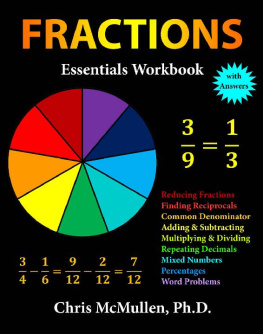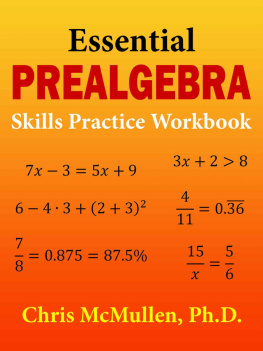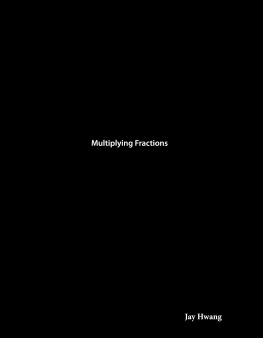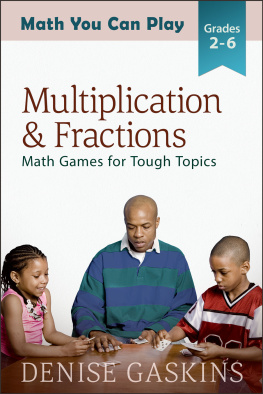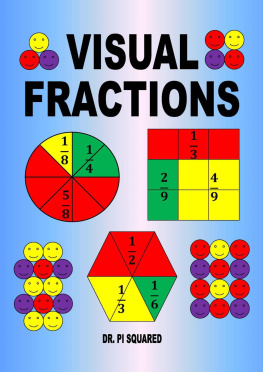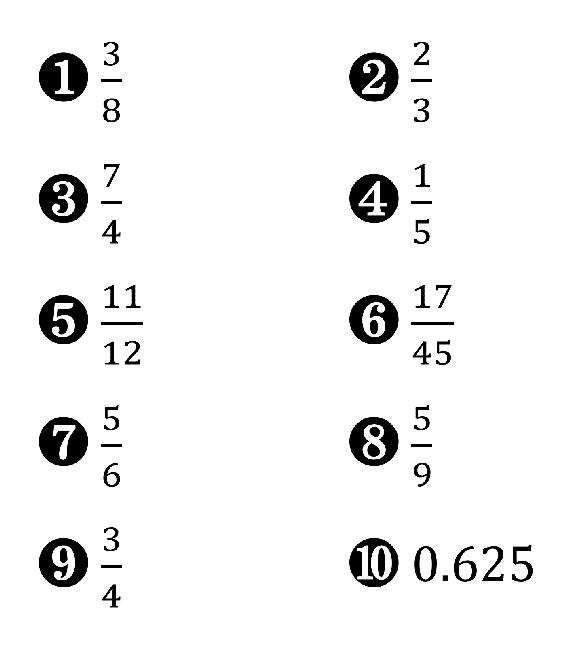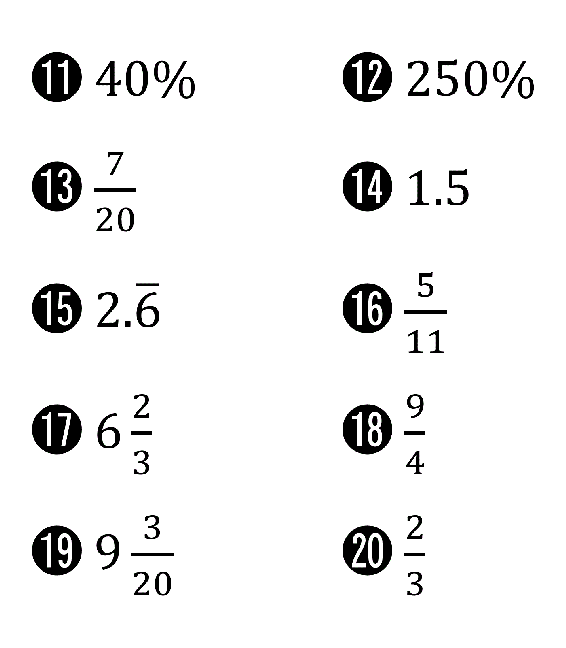This workbook is designed to help understand essentialfractions concepts and practice essential fractions skills. Each chapterfocuses on one main topic such as how to find a common denominator or how toconvert a mixed number into an improper fraction.
Every chapter begins with a concise explanation of the mainconcept, followed by a few examples. The examples are fully solved step-by-stepwith explanations, and should serve as a valuable guide for solving thepractice problems. The answer to every practice exercise is tabulated at theend of each chapter.
The workbook begins with a pretest assessment and concludeswith a posttest assessment. The idea behind the pretest is to assess yourunderstanding before you begin using the workbook. When you finish theworkbook, comparing the posttest with your pretest assessment can help you seehow much you have improved. Teachers may also find the pretest and posttestuseful for evaluating student improvement.
A variety of essential fractions skills are covered in thisworkbook. The first chapter starts out simple by showing how fractions can berepresented visually, and the difficulty of the lessons progresses as the bookcontinues. Students will learn how to do arithmetic with fractions, how toconvert to decimals or percentages, how to find repeating decimals, and how tosolve word problems that involve fractions.
Chapters 16-18 challenge the student by expressing a varietyof problems with mixed numbers (whereas the earlier chapters use improperfractions instead). The posttest exercises also challenge the student to applya variety of skills learned in this book.
May you (or your students) find this workbook usefuland become more fluent with these essential fractions skills.
Pretest Assessment
The purpose of this pretest is to help you (or a teacher orparent) see how much you already know about fractionsif anything. Its okay ifyou score low on the pretest: It just means that you havent learned much aboutfractions yet. The goal of this workbook is to help you learn. If you score lowon the pretest, it shows that you have much to gain by using this workbook.
A secondary goal of this pretest is to show you a sample ofthe kinds of fractions skills that you will learn in this workbook. If youdont know how to solve a problem on the pretest, dont worry: You will learnhow to solve it later in this book.
Write your answers down on a piece of scratch paper. Whenyou reach the end of the pretest, you will be able to access the answer key.Check your answers with the answer key, and add up the number of correctanswers (out of 20 possible) to score your pretest.
After you complete this workbook, taking the posttestand comparing with your pretest score will help you see how much you haveimproved.
(1) Express 15/40 as a reduced fraction.
(2) Which is bigger, 2/3 or 5/8?
(3) What is the reciprocal of 4/7?
(4) What is the reciprocal of 5?
(5) Evaluate 3/4 + 1/6. Express your answer as areduced fraction.
(6) Evaluate 3/5 2/9. Express your answer as areduced fraction.
(7) Evaluate 2/3 5/4. Express your answeras a reduced fraction.
(8) Evaluate 5/12 3/4. Express your answeras a reduced fraction.
(9) Express 0.75 as a reduced fraction.
(10) Express 5/8 in decimal form.
(11) Express 0.4 as a percentage.
(12) Express 5/2 as a percentage.
(13) Express 35% as a reduced fraction.
(14) Express 150% in decimal form.
(15) Express 8/3 as a repeating decimal.
(16) Express the following repeating decimal as a reducedfraction.
(17) Express the improper fraction 20/3 as a mixednumber.
(18) Express the following mixed number as an improper fraction.
(19) Evaluate the following sum of mixed numbers. Express youranswer as a mixed number.
(20) A parking lot has 6 red cars and 12 blue cars.What fraction of the cars are blue?
Pretest Answers
The answers to the pretest are organized in the tables that follow.
Notes:
(7) If you get 10/12, you didnt reduce your answer. SeeChapter 2.
(8) If you get 20/36 or 10/18, you didnt fully reduce youranswer. See Chapter 2.
(9) If you get 75/100, you didnt reduce your answer. SeeChapter 2.
(13) If you get 35/100, you didnt reduce your answer. SeeChapter 2.
(14) If your answer is 1.50, its customary to omit thetrailing zero.
(15) This means 2.666666 where the 6 repeats forever. SeeChapter 11.
(16) If you get 45/99 or 15/33, you didnt reduce youranswer. Note that 9/20 and 45/100 are both incorrect: Theproblem means 0.45454545 with the 45 repeating forever. The problem doesnt mean the same thing as 0.45. See Chapter 11.
(19) If you get 183/20, you forgot to convert the improperfraction to a mixed number, as shown in Chapter 16. If you get 8 and 23/20,your answer is correct, but your answer isnt in standard form. Note that 8 and23/20 equals 9 and 3/20 because 23/20 equals 1 and 3/20.
(20) If you get 12/18, 6/9, or 4/6, you didntfully reduce your answer. See Chapter 2.
Low score?
If you scored low on the pretest, dont worry: Thisjust shows that you can learn much by using this workbook. These are skillsthat we will learn. They arent things that you already need to know.
How did we get the answers?
Are you wondering how we got one of the answers?Well show you after you complete the posttest at the end of this book. Youwill learn these skills while using this workbook, and the posttest will helpyou see how much you have learned. We recommend that you dont read theexplanations for the posttest until youve completed this workbook and haveattempted the posttest. (However, if you really want to, you can use devicenavigation to visit the Posttest Answers now, and then return to Chapter 1when you finish. We didnt include a hyperlink right here since ourrecommendation is to read and work through this book before checking theposttest explanations.)

